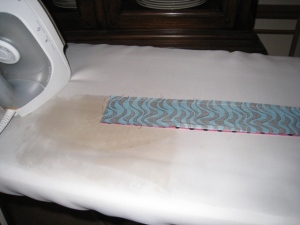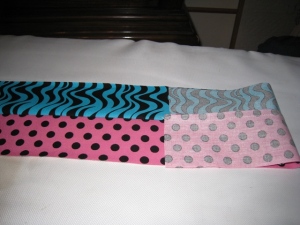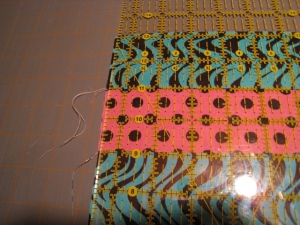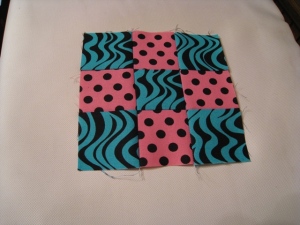So back in November 2009, I started a tutorial for making a 9 patch block but I didn’t finish it. Just like the quilt that I started for the tutorial is still sitting in the block box and not finished. However, there are some pictures from the first round that didn’t get posted so her is part 2 in How to Make a 9 Patch block quilt –
When we left off 3 years ago, I had suggested marking the 1/4″ seam allowance on the sewing machine like this.
The next step is to play with the iron. I like having a good heavy iron for quilting because it’s important to press with the iron, not “iron”. Rubbing the iron back and forth can stretch the fabric, especially when working on the bias in triangles.
The reason for putting the darker fabric on top is when you open the seam, it will then lay toward the darker fabric.
It’s really tempting to just slide the iron down the seam but it’s important to pick up the iron, set it down and press, pick up the iron, repeat. The times I slide the iron, I end up with curved seams. Press the entire length of the strip.
I was taught that whatever direction you open, is how the seam will lay.
The two really good suggestions I was given were 1. Go in the direction of the fewest seams and 2. Lay the seam to the darker color so it doesn’t show through.
Now add the third strip to this set.
So on your strip where the light fabric is on the inside the pressed seams lay toward the outside dark strips and where the light fabric is on the outside, the seams will lay toward the inside.
Now that we have the 2 sets of 3 strips, it’s time to cut them to make blocks.
Line one of the lines of the ruler with the line of the seam in order to get a perpendicular line, now you can use the rotary cutter to create a straight edge to your strips.
Cut new strips the same size as the original strips, in this case, I was using 2.5 inch strips so I’m going to cut this portion the same size as my original strips.
Lay out the strips to form the 9 patch blocks. I had enough to make 5 blocks 2 with the light fabric in the corners and 3 with the dark fabric in the corners.
So this is where my obsession with pressing the seams the correct direction come into play. Since we pressed all the seams to the dark side, we now have a way to make our corners perfect, abut the seams so they line up perfectly.
I seriously thought about telling people to press the block seams to the dark side again but I think I’ve hammered that enough.
So now you have five 9-patch blocks and a choice. How do you want to lay out the quilt?
I’ll hurry and finish my quilt this month and take more pictures. I won’t make people wait another 3 years for the remaining instructions but I’m not promising that it will be this weekend.













